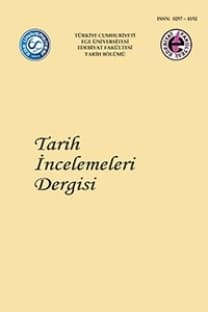Some Remarks About the Summer Period in Hittite Anatolia
Hittite, cuneiform texts, summer period, BURU14, Anatolia, traditional calendars
Some Remarks About the Summer Period in Hittite Anatolia
Hittite, cuneiform texts, summer period, BURU14, Anatolia, traditional calendars,
___
- Albayrak 1996 İrfan Albayrak, “Koloni Çağında Yerli Bir Bayan Adı “Madawada.”, III. Uluslararası Hititoloji Kongresi Bildirileri, Çorum, September 16-22, Ankara, pp.1-14. Beckman 1982 Gary Beckman, “The Anatolian Myth of İlluyanka”, Journal of Near Eastern Studies 14, pp. 11-25. Beckman 1983 Gary Beckman, Hittite Birth Rituals. Wiesbaden: Harrassowitz, StBoT 29. Beckman 2002 Gary Beckman, “The Babilili-ritual from Boğazköy (CTH 718)”, Recent Development in Hittite Archaeology and History, edited by K. A. Yener, H. A. Hoffner, S. Dhesi, Winona Lake, pp.35-42. Belmonte and Garcia 2014 Juan Antonio Belmonte and A. Cesar Gonzalez Garcia. “Astral Symbolism and Time Keeping in the Hittite Culture.” Paper presented Proceeding of the Eight International Congress of Hittitology, Warsaw, Septembre 5-9, 2011, pp. 110-123. Bittel 1970 Kurt Bittel, Hattusha, The Capital of the Hittites. New York: Oxford University Press. CHD L-N Chicago Hittite Dictionary, Vol. L-N, edited by H. G. Güterbock and H. A. Hoffner, Chicago, Illinois, Oriental Institute, 1989. CHD P Chicago Hittite Dictionary, Vol. P, edited by H. G. Güterbock and H. A. Hoffner, Chicago, Illinois, Oriental Institute, 1997. CHD Š-1 Chicago Hittite Dictionary, Vol. Š, Fascicle 1, edited by H. G. Güterbock, H. A. Hoffner and Theo P. J. van den Hout, Chicago, Illinois, Oriental Institute, 2002. Christopher 1995 J. Eyre Christopher, “The Agricultural Cycle, Farming and Water Management in the Ancient Near East”, In Civilizations of the Ancient Near East, edited by Jack Sasson, pp.185-188. Screibner, New York.
- ISSN: 0257-4152
- Yayın Aralığı: 2
- Başlangıç: 1983
- Yayıncı: Prof. Dr. Süleyman Özkan
II. Mahmud Devri Reformlarının Tebaa Tarafından Algılanışı
Power, Politics and Tradition in the Mongol Empire and the Īlkhānate of Iran
Kraliçe Tamara (Tamar) Devri (1184-1213) Gürcü Dış Politikası ve Bölgedeki Yansımaları
Eritre ve Etiyopya Arasındaki Danakil Bölgesinde Osmanlı Hâkimiyeti ve Kaymakam Pertev Efendi
1787-1792 Osmanlı Rus Savaşında Değişen Dengeler ve Yaş Antlaşması
Effects of the Decisions of San Remo Conference on Syria and Iraq
